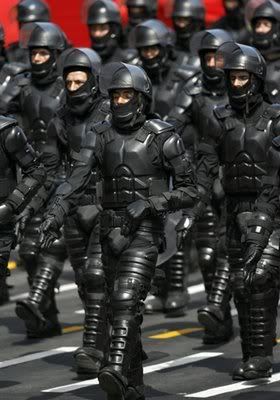 The U.S. military expects to have 20,000 uniformed troops inside the United States by 2011 trained to help state and local officials respond to a domestic catastrophe, according to Pentagon officials.
The U.S. military expects to have 20,000 uniformed troops inside the United States by 2011 trained to help state and local officials respond to a domestic catastrophe, according to Pentagon officials. WAIT! I THOUGHT THAT WAS WHAT THE NATIONAL GAURD WAS FOR?
There are critics of the change in the military who point out that the new surge of troops deployed in the US violates the Posse Comitatus Act, a 130-year-old federal law restricting the military's role in domestic law enforcement.
The Pentagon's plan calls for three rapid-reaction forces to be ready for emergency response by September 2011. The first 4,700-person unit, built around an active-duty combat brigade based at Fort Stewart, Ga., was available as of Oct. 1, said Gen. Victor E. Renuart Jr., commander of the U.S. Northern Command.
In late 2007, Deputy Defense Secretary Gordon England signed a directive approving more than $556 million over five years to set up the three response teams, known as CBRNE Consequence Management Response Forces.
Bert B. Tussing, director of homeland defense and security issues at the U.S. Army War College's Center for Strategic Leadership, said the new Pentagon approach "breaks the mold" by assigning an active-duty combat brigade to the Northern Command for the first time. Until now, the military required the command to rely on troops requested from other sources.
The Cato Institute are troubled by what they consider an expansion of executive authority. Domestic emergency deployment may be "just the first example of a series of expansions in presidential and military authority," or even an increase in domestic surveillance, said Anna Christensen of the ACLU's National Security Project. And Cato Vice President Gene Healy warned of "a creeping militarization" of homeland security.
There are critics of the change in the military who point out that the new surge of troops deployed in the US violates the Posse Comitatus Act, a 130-year-old federal law restricting the military's role in domestic law enforcement.
The Pentagon's plan calls for three rapid-reaction forces to be ready for emergency response by September 2011. The first 4,700-person unit, built around an active-duty combat brigade based at Fort Stewart, Ga., was available as of Oct. 1, said Gen. Victor E. Renuart Jr., commander of the U.S. Northern Command.
In late 2007, Deputy Defense Secretary Gordon England signed a directive approving more than $556 million over five years to set up the three response teams, known as CBRNE Consequence Management Response Forces.
Bert B. Tussing, director of homeland defense and security issues at the U.S. Army War College's Center for Strategic Leadership, said the new Pentagon approach "breaks the mold" by assigning an active-duty combat brigade to the Northern Command for the first time. Until now, the military required the command to rely on troops requested from other sources.
The Cato Institute are troubled by what they consider an expansion of executive authority. Domestic emergency deployment may be "just the first example of a series of expansions in presidential and military authority," or even an increase in domestic surveillance, said Anna Christensen of the ACLU's National Security Project. And Cato Vice President Gene Healy warned of "a creeping militarization" of homeland security.

No comments:
Post a Comment